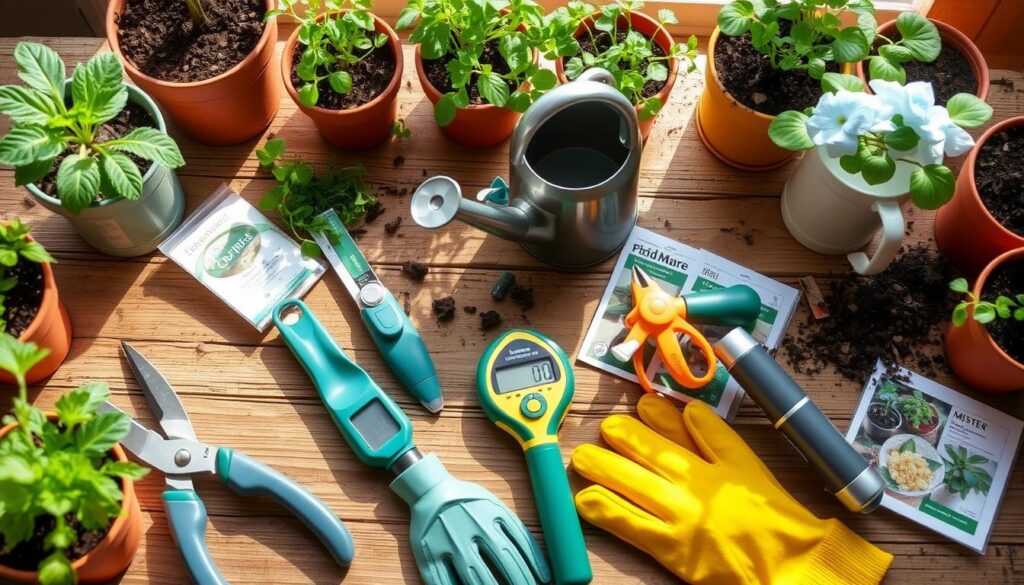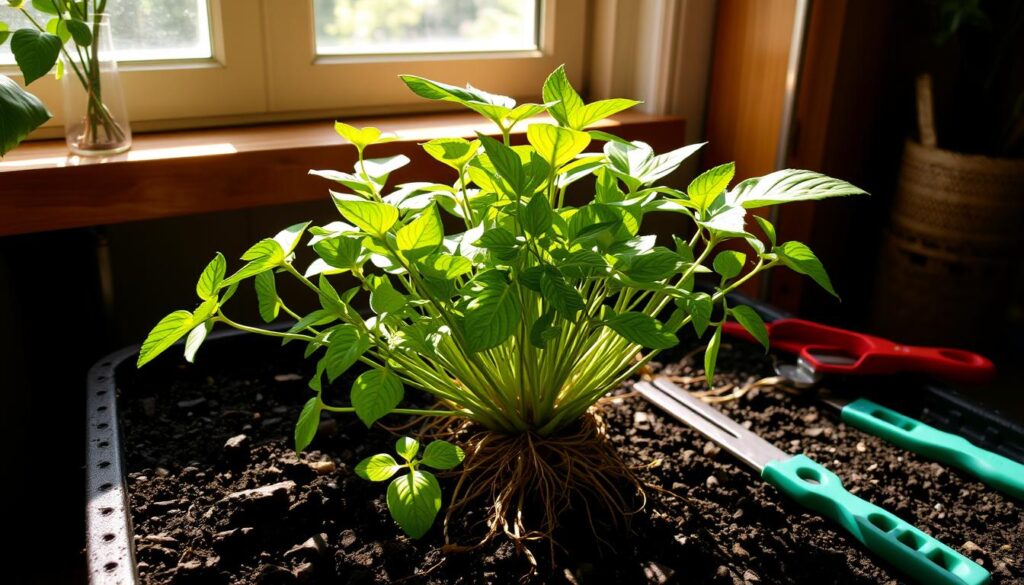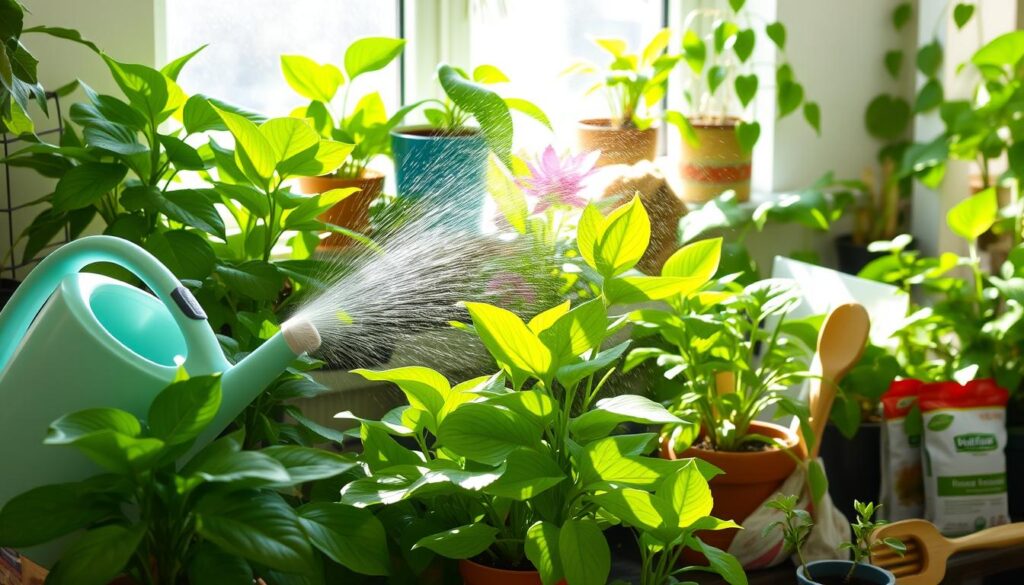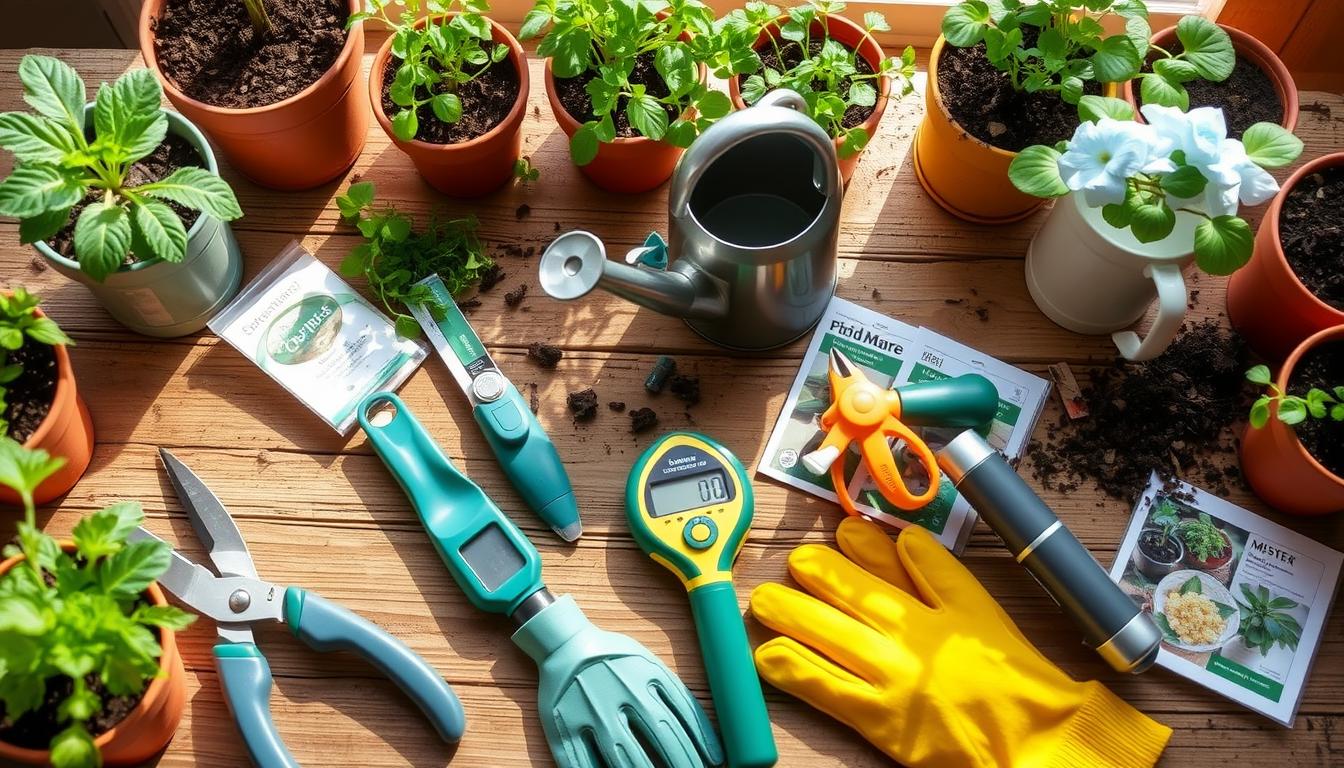Do you dream of lush greenery but find it hard to keep plants alive? 🌱 Plant care doesn’t have to be hard. Simple tips can turn any space into a lush oasis. Whether you’re new to indoor gardening or have lots of experience, knowing how to care for your plants is key.
This knowledge not only makes your plants look great but also boosts your mood. This article will share essential tips to help you grow vibrant, healthy plants easily.
Table of Contents
Understanding the Importance of Plant Care
Proper plant care is key to a healthy indoor garden. It keeps your plants looking good and feeling well. By taking care of your plants, you make your home look better and feel fresher.
Plant care does more than just make your home look nice. It keeps pests and diseases away, helping your plants stay healthy for a long time. A happy indoor garden makes your home a cozy place, lifting your mood as you enjoy nature indoors.
Learning about plant care helps you create a space where plants can thrive. Knowing what each plant needs is the first step to a successful garden. By focusing on plant care, you make your home a reflection of your style and improve your life.
| Plant Type | Light Requirements | Watering Needs | Benefits |
|---|---|---|---|
| Spider Plant | Indirect sunlight | Every 1-2 weeks | Air purification, easy to care for |
| Pothos | Low to bright indirect light | Once a week | Enhances humidity, promotes relaxation |
| Peace Lily | Low to medium light | Once a week | Improves air quality, low maintenance |
| Snake Plant | Low light | Every 2-6 weeks | Tolerates drought, unique appearance |
Essential Plant Care Tools You Should Have
Having the right tools is key to a great indoor gardening experience. Essential tools help keep your plants healthy and growing well. For beginners, knowing which tools to use and how is crucial for success.
Must-Have Tools for Beginners
- Watering Can: A good quality watering can is essential. It lets you control water flow, avoiding too much water.
- Pruning Shears: These are needed for cutting off dead or sick leaves and stems. This keeps your plants healthy.
- Soil Moisture Meter: This tool shows the soil’s moisture level. It tells you when to water your plants.
- Hand Shovel: Great for digging and planting in tight spaces, a hand shovel is handy.
How to Use Each Tool Effectively
Knowing how to use each tool is important. When watering, check the soil first. If it’s damp, wait a bit before watering again. For pruning, make clean cuts at an angle to help the plant heal faster.
Using a soil moisture meter right means inserting it at the root level. This gives you an accurate reading, so you don’t water too often. And when digging with a hand shovel, be gentle to avoid harming roots.

Watering Techniques for Healthy Plants
Watering is key to keeping houseplants healthy. Knowing how to water them right can make a big difference. Each plant is different, so they need the right amount of water.
Deep watering is a good method. It helps roots grow deeper, making plants stronger. This way, plants get water and nutrients better.
Moisture meters are also helpful. They tell you when to water by checking soil moisture. This helps avoid watering too much or too little.
It’s important to keep the soil moist but not too wet. Too much water can harm plants. Adjust how often you water based on the season and how hot or humid it is.
Here’s a table showing some indoor plants and how often to water them:
| Plant Type | Watering Frequency | Watering Techniques |
|---|---|---|
| Spider Plant | Every 1-2 weeks | Water deeply and allow the top inch of soil to dry out |
| Snake Plant | Every 2-3 weeks | Wait for soil to dry completely before watering |
| Pothos | Weekly | Soak thoroughly, then let excess water drain |
| Peace Lily | Once a week | Water when the topsoil feels dry to the touch |
| Fiddle Leaf Fig | Every 1-2 weeks | Ensure thorough watering, avoiding waterlogged soil |
Using the right watering methods can make your plants healthier. By learning how to water them well, you can have a beautiful indoor garden.
Plant Care Tips for Optimal Soil Conditions
Creating the right soil conditions for plant health is key for indoor plants to do well. The soil you choose affects how well it holds moisture and gives nutrients. Knowing how to pick and care for the best soil can make your indoor plants look lush and green.
Choosing the Best Soil for Indoor Plants
When picking the best soil for indoor plants, think about what each plant needs. Some plants like soil that drains well, while others prefer soil that holds moisture. Here are some common soil types:
- Potting Mix: Great for most indoor plants, it’s a mix of peat moss, vermiculite, and perlite.
- Organic Soil: Rich in natural stuff, it’s good for plants that are sensitive.
- Cactus Mix: Perfect for desert plants, it drains well and stays dry.
Choosing a soil that matches your plants’ needs helps them grow strong and healthy.
Importance of Aerating Soil
Aerating soil is vital for healthy roots and preventing soil compaction. Regular aeration lets roots breathe better and improves water flow. Ways to aerate soil include:
- Using a Soil Aerator: This tool makes small holes in the soil for better air and water.
- Manual Aeration: Using a stick to poke holes is less efficient but works.
- Mixing in Sand or Perlite: This makes the soil less dense and improves aeration.
By keeping your soil aerated, you improve soil conditions for plant health. This lets your indoor plants thrive.

| Soil Type | Best For | Texture |
|---|---|---|
| Potting Mix | General Indoor Plants | Light and airy |
| Organic Soil | Sensitive Plants | Rich and dense |
| Cactus Mix | Cacti and Succulents | Grainy and well-draining |
Common Plant Care Mistakes to Avoid
Keeping your plants healthy means knowing common mistakes. Spotting signs of unhealthy plants early can prevent bigger problems. Overwatering and pests are two big issues that can harm your plants.
Signs of Unhealthy Plants
It’s important to know when your plants are in trouble. Look out for these signs:
- Yellowing leaves – This usually means too much water or not enough nutrients.
- Stunted growth – If your plants aren’t growing well, they might need better soil or more light.
- Wilting – This could mean you’re watering too much or too little. Check the soil moisture.
- Pest presence – Look for pests on leaves or a sticky substance that can harm your plants.
How to Prevent Overwatering
To avoid overwatering, try these tips:
- Set up a watering routine that fits each plant’s needs.
- Choose pots with drainage holes to let water out.
- Check soil moisture with meters or by feeling it with your finger.
- Learn how your plants usually grow and adjust watering based on that.
How to Revive Dying Plants
Reviving a struggling plant needs careful observation and practical steps. It’s important to know the signs of distress before starting the revitalization process.
Identifying the Signs of Distress
Spotting trouble in your plant early can prevent lasting damage. Look out for:
- Yellowing leaves
- Wilting or drooping stems
- Leaf drop
- Brown tips on leaves
- Stunted growth
Step-by-Step Revitalization Techniques
After spotting distress signs, use these steps to revive your plant:
- Assess Watering Habits: Too much or too little water can harm your plant. Adjust your watering based on your plant’s needs.
- Prune Dead Leaves: Cut off dead or yellow leaves. This helps your plant focus on growing new leaves.
- Evaluate Light Conditions: Make sure your plant gets enough light. Move it to a brighter spot or add extra lighting if needed.
- Check Soil Quality: Bad soil can hurt your plant. Replace the soil if it’s too dense or lacks nutrients.
- Monitor Progress: Watch your plant after applying these steps. Recovery might take time, so be patient.
Best Practices in Plant Care
To keep your garden or indoor plants thriving, follow the best care practices. Knowing how important plant nutrition is key to healthy growth. Using fertilizers regularly helps your plants get the nutrients they need.
If you’re into eco-friendly gardening, look into organic fertilizers. They feed your plants and help the planet. Remember, different plants need different nutrients, so choose wisely.
Light and humidity are also crucial for your plants. Each plant needs a certain amount of light. Make sure you provide the right amount for your plants.
Don’t forget about regular care like pruning and checking for pests. These steps help prevent diseases and promote strong growth. By following these practices, you’ll create a great environment for your plants.

| Best Practices | Description |
|---|---|
| Nutrient Management | Apply organic fertilizers based on specific plant needs to ensure healthy growth. |
| Light Requirements | Provide sufficient and appropriate light levels for different plant species. |
| Humidity Control | Maintain optimal humidity levels to prevent plant stress and diseases. |
| Regular Maintenance | Engage in pruning and pest control for sustained plant health. |
Plant Care Tips for Seasonal Changes
Knowing what your plants need through the seasons is key to their health. This guide shows how to adjust your care as seasons change. Winter, in particular, needs special care to keep plants healthy indoors and outdoors.
By using winter plant care tips, your plants can stay healthy through the seasons. This is true even when the climate changes.
Winter Plant Care Tips
In winter, plants get less sunlight and humidity. This means you need to change how you care for them. Here are some important tips:
- Reduce watering: Many plants need less water in winter because they’re dormant.
- Increase humidity: Use humidifiers or pebble trays with water to keep moisture up.
- Adjust light exposure: Move plants closer to windows or use grow lights for more light.
- Monitor temperature: Keep your indoor space consistent and away from drafts or heating vents.
Adjusting Care in Different Climates
Every climate has its own challenges and opportunities for plant care. Knowing your local conditions is crucial. Here are some tips for adjusting care based on your climate:
- Warm climates: Provide shade and enough water to protect plants from heat.
- Cold climates: Move plants indoors to avoid frost and watch indoor conditions closely.
- Humid climates: Make sure plants have good drainage to avoid root rot from too much water.
- Arid climates: Choose drought-resistant plants and find ways to water efficiently.
Green Plant Care Tips for Techs: Growing Plants in Glass Bottles
Growing plants in glass bottles is an innovative way to incorporate greenery into your home or office. These transparent containers allow you to observe the roots’ growth while providing an aesthetic touch. However, like any other plant care method, growing plants in glass bottles requires specific care.
5 Ways to Take Care of Plants in Glass Bottles
- Choose the Right Plant
Some plants thrive in a closed environment like glass bottles, while others may not. Succulents, air plants, and small ferns are ideal for bottle gardens because they don’t require much space or frequent watering. - Watering Routine
Overwatering can be detrimental to plants in glass bottles. It’s essential to let the water drain and only water when the soil feels dry. Consider using a small watering can or pipette for precision. - Provide Adequate Light
Place your glass bottle in a location where it can receive indirect sunlight. Avoid direct sunlight, as it can cause the bottle to heat up and damage the plants. - Clean the Bottle Regularly
Condensation can build up inside the bottle, creating an ideal environment for mold. Clean the glass regularly to prevent this and to ensure the plants have a healthy growing space. - Pruning and Maintenance
Trim any overgrown plants to ensure they don’t outgrow their space. Pruning will help maintain the aesthetic and health of the plants.
Greenhouse Growing Tips: What to Grow and When
What to Grow in a Greenhouse for Beginners
Starting a greenhouse can be a rewarding experience. For beginners, it’s important to start with easy-to-grow plants that require minimal care. Here are some suggestions:
- Herbs: Basil, mint, parsley, and thyme are all great options for greenhouse gardening.
- Leafy Greens: Lettuce, spinach, and kale grow well in greenhouses and can thrive throughout the year.
- Tomatoes and Cucumbers: These popular vegetables require consistent warmth, making them perfect for greenhouse environments.
Greenhouse Cultivation PDF
For those looking for a comprehensive guide, a greenhouse cultivation PDF can provide detailed information on greenhouse management, temperature control, humidity levels, and plant selection.
What Can I Grow in a Greenhouse All Year-Round?
A greenhouse allows for year-round gardening, making it possible to grow a variety of plants throughout the seasons. Vegetables like kale, spinach, and herbs can be grown in colder months, while tomatoes and cucumbers can flourish in warmer months. A well-maintained greenhouse can help regulate temperature and humidity, creating a stable environment for year-round growth.
Greenhouse Planting Schedule
The key to successful greenhouse gardening is understanding when to plant certain crops. Here’s a basic schedule:
- Spring (March to May): Start seeds for tomatoes, peppers, and cucumbers.
- Summer (June to August): Harvest crops like tomatoes and cucumbers.
- Fall (September to November): Plant cool-season crops like lettuce and spinach.
- Winter (December to February): Focus on hardy greens and herbs.
What is Greenhouse Gardening?
Greenhouse gardening involves growing plants in a controlled environment, typically a glass or plastic structure. It provides protection from weather conditions and pests, making it an ideal method for cultivating a wide variety of plants year-round. For more details on greenhouse gardening, check out Greenhouse Gardening on Wikipedia.
Unusual Things to Grow in a Greenhouse
For those looking to experiment, there are plenty of unusual plants to grow in a greenhouse, such as:
- Exotic fruits like bananas and pineapples.
- Tropical flowers such as orchids and anthuriums.
- Specialty herbs like lavender and rosemary.
Conclusion
Greenhouse gardening offers numerous benefits, from growing plants all year-round to experimenting with unusual crops. For beginners, starting with easy-to-grow vegetables and herbs can help build confidence. Be sure to maintain your greenhouse environment, keep your plants well-watered, and monitor the light and temperature to ensure optimal growth.
For more tips on gardening and maintaining a thriving plant environment, check out these helpful resources:
External Links:
Vegetable Growing in Greenhouses – Wikipedia
Greenhouse Gardening – Wikipedia
What to Grow in a Greenhouse – Wikipedia
FAQ
What are some essential plant care tips for beginners?
Start by picking easy-to-care-for houseplants. Learn how to water them right and choose the best soil. Also, know common mistakes to avoid and get the right tools.
How do I know when to water my houseplants?
Check the soil moisture with a moisture meter or your finger. If it’s dry, it’s time to water. Stick to a watering schedule for each plant to avoid too much water.
What is the best soil for indoor plants?
The best soil mix drains well, breathes, and has nutrients. Look for organic matter in the mix. Adding peat or perlite helps with moisture and drainage.
What essential tools do I need for plant care?
You’ll need watering cans, pruning shears, moisture meters, and hand shovels. These tools help keep your plants healthy by ensuring proper watering, pruning, and soil care.
What are some common plant care mistakes?
Don’t overwater, ensure enough light, and handle pests. Watch for signs like yellow leaves or slow growth. Adjust your care to fix these issues.
How can I revive dying plants?
First, identify the problem, like droopy leaves. Change your watering, check the light, and prune dead parts. This encourages new growth.
What are the best practices for fertilizing houseplants?
Choose the right fertilizer for your plants. Follow the application instructions and consider organic options. Regular feeding supports healthy growth.
How do I care for my indoor plants during the winter?
In winter, water less, increase humidity, and watch for pests. Place plants near windows or use grow lights for enough light.
What lighting conditions are best for houseplants?
Most houseplants prefer bright, indirect light. But, each plant has its own needs. Research your plants to find the best light spot.
How can I prevent pests from infesting my houseplants?
Regularly check your plants for pests. Keep the soil healthy and water consistently. Natural pest control can help if problems arise.


4 thoughts on “#7 Plant Care Tips for Thriving Green Spaces and Happy Plants”